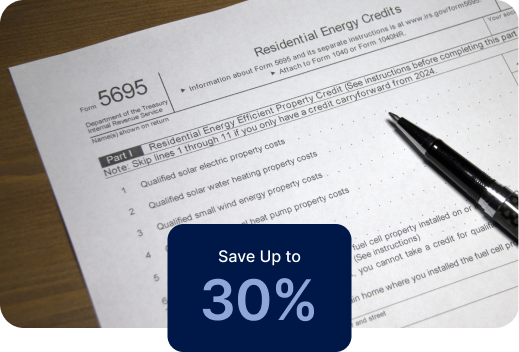The renewable energy sector continues to expand, despite policy uncertainty under the Trump administration.
Utah Solar Incentives: 2025 Overview
Utah provides strong incentives to make solar energy affordable. Homeowners can benefit from the 30% Residential Clean Energy Credit, and Utah offers a state tax credit to further reduce installation costs. Net metering programs allow residents to earn credits for excess energy, lowering future bills. With abundant sunshine, going solar in Utah is a smart…

Residential Clean Energy Credit
The Clean Electricity Investment Credit (previously called the Federal Investment Tax Credit) helps lower the cost of installing solar panels by 30%. This credit covers everything: the solar panels, equipment, labor, permits, and even sales tax.
For example, as of 2025 the average cost of a 10 kW solar system in the U.S. typically ranges between $21,000 and $29,500 before applying any federal tax incentives. After claiming the 30% Clean Electricity Investment Credit, the price drops to around $14,980 to $21,070, depending on the state and other factors like equipment quality and labor costs.
To claim this credit, you must buy your solar system with cash or a loan (leases don’t qualify). You also need to owe enough in taxes to claim the credit, but if you don’t, you can carry it over to future years until 2034.

Claiming the Clean Electricity Investment Credit is simple!
Step 1
Print IRS Form 3468
Step 2
Fill out the form using info from your installer
Step 3
Submit it when you file your taxes
What are the top solar incentives in Utah?
Besides the Clean Electricity Investment Credit (former ITC), homeowners can take advantage of several outstanding incentives that significantly enhance the return on investment for solar panels. Here are some of the most effective ways to lower your solar installation costs.
Incentive
Savings
Summary
Residential Renewable Energy Tax Credit
A taxpayer may claim a credit of 30% of qualified expenditures, after deducting incentives, with no upper limit for a system that serves a dwelling unit located in the United States that is owned and used as a residence by the taxpayer. Expenditures with respect to the equipment are treated as made when the installation is completed. If the installation is at a new home, the “placed in service” date is the date of occupancy by the homeowner. Expenditures include labor costs for on-site preparation, assembly or original system installation, and for piping or wiring to interconnect a system to the home. If the federal tax credit exceeds tax liability, the excess amount may be carried forward to the succeeding taxable year. The excess credit may be carried forward until 2019, but it is unclear whether the unused tax credit can be carried forward after then.
Residential Solar Incentive
Service under this schedule is intended to promote the installation of solar photovoltaic (PV) electric generation equipment by customers designed to offset electricity usage on the system site. Residential participants must be current Utah customers of Rocky Mountain Power, with accounts in good standing. The incentive amount is limited to 4 kW (AC) and will only be paid directly to the utility customer.
Renewable Energy Systems Tax Credit
The Utah Office of Energy Development administers the tax credit and has responsibility for revising the tax credit rules and certifying systems as eligible for the credit. Legislation enacted in 2007 extended these tax credits through at least 2012. On or before this time, and every five years thereafter, the Utah Tax Review Commission must review the tax credit and make recommendations as to whether the tax credit should be continued, modified, or repealed. The revised tax credit is applicable to systems placed in service on or after January 1, 2007. Taxpayers wishing to use this tax credit must first apply through the Utah State Energy Program before claiming the tax credit against their Utah state taxes.
Residential Solar Incentive
Service under this schedule is intended to promote the installation of solar photovoltaic (PV) electric generation equipment by customers designed to offset electricity usage on the system site. Residential participants must be current Utah customers of Rocky Mountain Power, with accounts in good standing. The incentive amount is limited to 4 kW (AC) and will only be paid directly to the utility customer.
Residential Solar Incentive
Service under this schedule is intended to promote the installation of solar photovoltaic (PV) electric generation equipment by customers designed to offset electricity usage on the system site. Residential participants must be current Utah customers of Rocky Mountain Power, with accounts in good standing. The incentive amount is limited to 4 kW (AC) and will only be paid directly to the utility customer.
Residential Solar Incentive
Service under this schedule is intended to promote the installation of solar photovoltaic (PV) electric generation equipment by customers designed to offset electricity usage on the system site. Residential participants must be current Utah customers of Rocky Mountain Power, with accounts in good standing. The incentive amount is limited to 4 kW (AC) and will only be paid directly to the utility customer.
Residential Solar Incentive
Service under this schedule is intended to promote the installation of solar photovoltaic (PV) electric generation equipment by customers designed to offset electricity usage on the system site. Residential participants must be current Utah customers of Rocky Mountain Power, with accounts in good standing. The incentive amount is limited to 4 kW (AC) and will only be paid directly to the utility customer.
Residential Solar Incentive
Service under this schedule is intended to promote the installation of solar photovoltaic (PV) electric generation equipment by customers designed to offset electricity usage on the system site. Residential participants must be current Utah customers of Rocky Mountain Power, with accounts in good standing. The incentive amount is limited to 4 kW (AC) and will only be paid directly to the utility customer.
Renewable Energy Systems Tax Credit
The individual income tax credit for residential systems is 25% of the reasonable installed system costs up to a maximum credit of $2,000 per residential unit. The residential credit is nonrefundable, but unused credit may be carried forward for up to four years. Eligible residential systems include active and passive solar thermal systems; solar electric systems; wind turbines; hydro (water) energy; geothermal heat pumps; direct-use geothermal; and biomass. Note that eligible biomass systems must produce either fuel or electricity. Biomass heating systems are not eligible.
Renewable Energy Systems Tax Credit
The individual income tax credit for residential systems is 25% of the reasonable installed system costs up to a maximum credit of $2,000 per residential unit. The residential credit is nonrefundable, but unused credit may be carried forward for up to four years. Eligible residential systems include active and passive solar thermal systems; solar electric systems; wind turbines; hydro (water) energy; geothermal heat pumps; direct-use geothermal; and biomass. Note that eligible biomass systems must produce either fuel or electricity. Biomass heating systems are not eligible.
Renewable Energy Systems Tax Credit
The individual income tax credit for residential systems is 25% of the reasonable installed system costs up to a maximum credit of $2,000 per residential unit. The residential credit is nonrefundable, but unused credit may be carried forward for up to four years. Eligible residential systems include active and passive solar thermal systems; solar electric systems; wind turbines; hydro (water) energy; geothermal heat pumps; direct-use geothermal; and biomass. Note that eligible biomass systems must produce either fuel or electricity. Biomass heating systems are not eligible.
Renewable Energy Systems Tax Credit
The individual income tax credit for residential systems is 25% of the reasonable installed system costs up to a maximum credit of $2,000 per residential unit. The residential credit is nonrefundable, but unused credit may be carried forward for up to four years. Eligible residential systems include active and passive solar thermal systems; solar electric systems; wind turbines; hydro (water) energy; geothermal heat pumps; direct-use geothermal; and biomass. Note that eligible biomass systems must produce either fuel or electricity. Biomass heating systems are not eligible.
Residential Renewable Energy Tax Credit
A taxpayer may claim a credit of 26% of qualified expenditures, after deducting incentives, with no upper limit for a system that serves a dwelling unit located in the United States that is owned and used as a residence by the taxpayer. Expenditures with respect to the equipment are treated as made when the installation is completed. If the installation is at a new home, the “placed in service” date is the date of occupancy by the homeowner. Expenditures include labor costs for on-site preparation, assembly or original system installation, and for piping or wiring to interconnect a system to the home. If the federal tax credit exceeds tax liability, the excess amount may be carried forward to the succeeding taxable year. The excess credit may be carried forward until 2019, but it is unclear whether the unused tax credit can be carried forward after then.
Residential Renewable Energy Tax Credit
A taxpayer may claim a credit of 22% of qualified expenditures, after deducting incentives, with no upper limit for a system that serves a dwelling unit located in the United States that is owned and used as a residence by the taxpayer. Expenditures with respect to the equipment are treated as made when the installation is completed. If the installation is at a new home, the “placed in service” date is the date of occupancy by the homeowner. Expenditures include labor costs for on-site preparation, assembly or original system installation, and for piping or wiring to interconnect a system to the home. If the federal tax credit exceeds tax liability, the excess amount may be carried forward to the succeeding taxable year. The excess credit may be carried forward until 2019, but it is unclear whether the unused tax credit can be carried forward after then.
Residential Renewable Energy Tax Credit
A taxpayer may claim a credit of 30% for the installation which was between 2022-2032 (Systems installed on or before December 31, 2019 were also eligible for a 30% tax credit), with no upper limit for a system that serves a dwelling unit located in the United States that is owned and used as a residence by the taxpayer. Expenditures with respect to the equipment are treated as made when the installation is completed. If the installation is at a new home, the placed in service date is the date of occupancy by the homeowner. Expenditures include labor costs for on-site preparation, assembly or original system installation, and for piping or wiring to interconnect a system to the home.
Disclaimer: The information provided here regarding solar incentives, tax credits, and rebates is for general informational purposes only and may vary based on your specific circumstances. For exact details, eligibility requirements, and current rates, we recommend consulting a certified solar installer or a tax professional. Incentives can differ by location, utility provider, and individual project, so it’s important to get personalized advice for your solar installation. Always verify the most up-to-date information from your local solar installer to understand how these incentives apply to your project.
Knowledge Base
Find everything you need to know about solar in your state and nationwide

Get a Quote
Discover the Ideal Solar System for Your Home in Just a Few Clicks!







